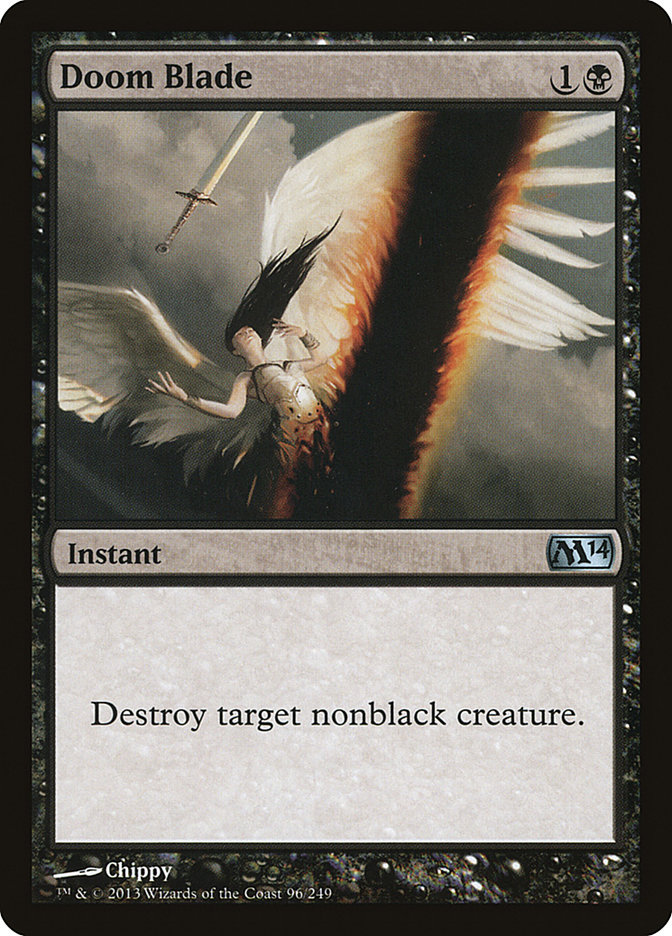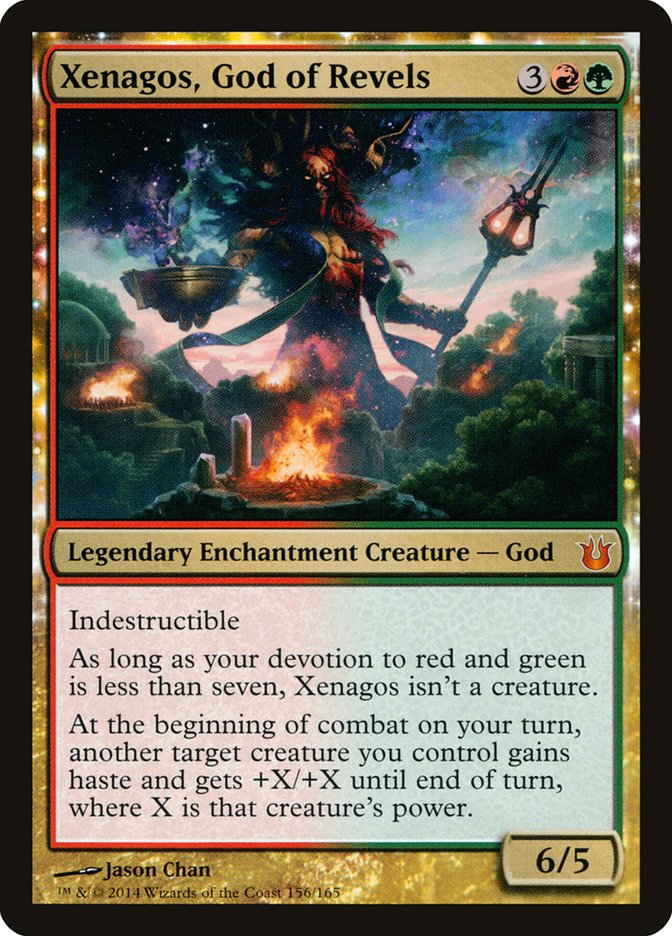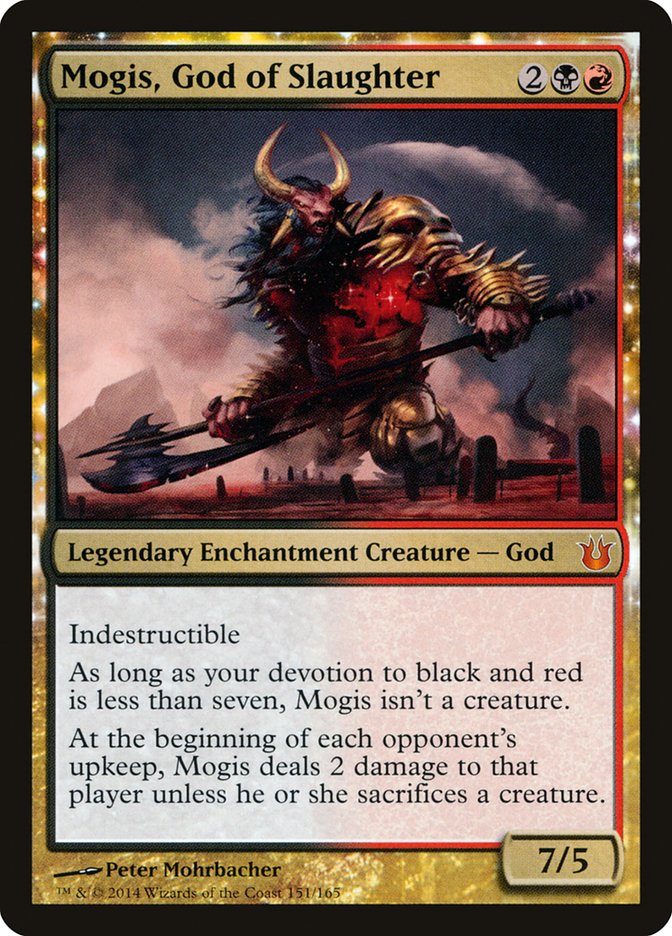Most of these articles so far have been about the specifics of the SCG Open Series, and that’s all well and good. Lots of cool decks crop up from week to week, and each tournament has its own stories and surprises. Baltimore was no different. Legacy was especially sweet, with Kurt Spiess winning with Lands. Kurt’s mixture of incredible play and fortune on camera made his run the best of 2014 in my opinion, and I strongly suggest going back and watching the replays of his matches if you haven’t already. But I’d rather discuss Standard for this one on the heels of the results from Grand Prix Vancouver and the Open in Baltimore and with Born of the Gods looming on the horizon.
As we conclude the current Standard format, I think it’s safe to say that three decks have risen to the top of the metagame: Mono-Black Devotion, Mono-Blue Devotion, and some sort of Sphinx’s Revelation deck. There have been other decks with good showings, such as various Chained to the Rocks strategies, G/R Monsters, W/R Aggro. But those decks have been trending downward overall, and last weekend is especially damning. Baltimore had a Mono-Black Devotion mirror in the finals, while all eight decks in Vancouver were one of the three archetypes in question.
This isn’t intrinsically horrible—many Standard formats have featured three “good” decks with some other stuff hanging around the fringes by season’s end, and several Standard formats have been much worse. And after all, that’s what new sets are for—to shake up stale formats and give players new tools for exploration. Many of the new cards are quite powerful, potentially giving some much-needed juice to several decks that have fallen by the wayside.
Right now I’m skeptical. Again, this is not because of insufficient power in Born of the Gods; plenty of the cards are “good” or even potentially “very good.” But two of the three best decks in Standard are crammed full of cards that ignore text boxes, and that raises the barrier of entry to any new cards in the format unless they already fit in one of those two shells. We can see evidence of this shaping up back in M14 with the reprinting of Doom Blade.
Now, Doom Blade is not a disaster by any means. The fact that we’re talking about a card like Doom Blade at all is something of a triumph for R&D. I played Standard formats where someone casting Plow Under on turn 3 was the “good guy” because other decks were trying to kill on the second turn, so this is all relative. Still, it seemed to me at the time as something of a departure from the philosophy displayed during Innistrad/Return to Ravnica Standard. Many of the Terrors were much narrower in scope (think Victim of Night and company), so the threats and answers one wanted to play from week to week fluctuated. This dynamic led to a very healthy and natural metagame evolution that continued for the duration of the season.
In what world is Doom Blade not very commonly played in Standard decks? In what scenario does Doom Blade qualify as “narrow?” In my mind, in only one of two situations—creatures in general aren’t very good or black decks are an overwhelming percentage of the metagame. Neither of these are good places. In most normal metagames, Doom Blade is probably in a bunch of decks, stifling some amount of innovation because there’s a very small list of creatures you can play that interact differently against Doom Blade. And since Doom Blade is priced for tournament-level Magic, there’s almost no way this doesn’t come up.
To whatever very small error in judgment Doom Blade represents, it pales in comparison to the Thoughtseize reprint. I’ve discussed this at some length, as have many others. We can no longer argue about the card’s power level. Legacy is a format with thousands of spells to choose from, and Thoughtseize is one of the 50 or so most commonly selected for inclusion in decks.
What is Thoughtseize good against? “People trying to do stuff” basically. How do you fight Thoughtseize? By either being extremely redundant and linear (think Mono-Red Aggro and similar decks) or by playing a bunch of card drawing and trying to out-economy it (think U/W Control). What you stay away from are decks trying to explore synergies or combinations of cards, and it’s no surprise we’ve seen a lot of those decks become less popular as the format has become more solved.
The U/W issue has been present since Return to Ravnica. It got the lion’s share of powerful cards compared to any other guild, and the cards play very cohesively together. Azorius Charm, Detention Sphere, and Supreme Verdict represent a powerful set of reactive cards (and again, are very good at answering a broad swath of cards), and Sphinx’s Revelation gives it the best inevitability in the format.
The only thing that suppresses this deck is a fluid changing format—if it’s forced to play reactive cards that aren’t efficient against every opponent, other decks can capitalize on that, and a diverse metagame can exist in spite of the pressures that these cards place on the format. The narrower the format becomes (in the case of Mono-Black Devotion, suppressing a good deal of the potential field), the more the U/W deck can sculpt its answers to the few remaining opponents, and this is where we are.
When decks or formats are full of powerful reactive cards, it’s important for players to be able to say “what can I add to my deck to beat this/reduce its effectiveness?” This goes back to the Innistrad/Return to Ravnica Standard I was talking about. People playing Ultimate Price? Maybe I should play Boros Reckoner. Pillar of Flame everywhere? I should look for three-toughness creatures. Compare that world to:
Doom Blade: “Play black creatures.”
Thoughtseize: ” . . . “
Hero’s Downfall: ” . . . “
Detention Sphere: ” . . . “
And you can see how the metagame is less likely to evolve even with the inclusion of additional content. There’s just not a large enough pool of cards that interact against things like this differently enough to make the cards you put in your deck appreciably different from one another. This leads to winning decks such as:
Creatures (16)
Lands (26)
Spells (18)
Sideboard

And Alexander Hayne’s winning list from Grand Prix Vancouver:
Creatures (1)
Planeswalkers (7)
Lands (27)
Spells (25)
- 4 Last Breath
- 3 Syncopate
- 2 Azorius Charm
- 4 Supreme Verdict
- 4 Detention Sphere
- 4 Sphinx's Revelation
- 4 Dissolve
Sideboard

Looking at these maindecks, only Pharika’s Cure and Last Breath represent any sort appreciation for the specifics of opposing text boxes. The rest of these decks are composed of card advantage/economy, broad-stroke answers to opposing cards of all sorts, and some ways to win the game. We’ve seen control decks like this before, but even for control decks they are quite uninterested in opposing text boxes. It’s pretty rare for the two best decks in the format (which I would argue these two are in some variation) to take on this kind of shape.
I think this is also the reason the format is advocated by some of the community’s best players—since the answer cards handle nearly every threat with equal efficiency, it’s very unlikely one loses the game to having an answer card line up inappropriately against an opposing threat card, and this dynamic rewards the more skilled player. However, this comes at the huge cost of metagame evolution and exploration, which should be the overriding concern. And rewarding the better player an enormous percentage of the time comes with other risks as well.
Since it’s nearly impossible to outdraw decks with Underworld Connections / Erebos, God of the Dead or Jace, Architect of Thought / Sphinx’s Revelation and since we’ve established that specific text boxes don’t really matter, the one front you can beat these decks on is mana efficiency. However, that road is also fraught with peril. Aggressive linear strategies have a tough time handling Jace, Architect of Thought and Supreme Verdict, and most fold to either Pack Rat or Desecration Demon (and sometimes both). And Mono-Black Devotion is picking up Drown in Sorrow for good measure.
So where do we go from here? It makes sense to draw information from Mono-Blue Devotion, the other consistently successful deck of the format. It plays a really low curve in an attempt to capitalize on the other decks being a little slow out of the gate, but most importantly it plays Thassa, God of the Sea. Neither U/W nor Mono-Black are flush with answers to opposing Gods, and the mixture of raw power and the ability to threaten a lot of damage out of nowhere allows Mono-Blue to hang with decks that are objectively a lot more powerful.
Both Xenagos, God of Revels and Mogis, God of Slaughter are powerful enablers for attacking strategies and put a lot of pressure on opposing decks to answer threat cards immediately, and B/R and G/R strategies have been reasonable fringe options for much of the season. I would keep an eye out for those two cards especially.
A few other decks on the outskirts of the format also provide potential solutions. Both Esper Humans and G/W Aggro have a structurally sound plan (low curve with either Xathrid Necromancer or Voice of Resurgence as a way to pressure removal). With additional similar threats or even just a general increase in overall power level, it’s possible these decks could become legitimate foils to Mono-Black Devotion and U/W Control. Both of these decks are saddled with atrocious mana, however, which may cap how powerful they become unless significant efforts are made to correct that issue.
None of this is meant to be a call for bannings or anything else extreme. We have lots of time to explore the new set, and Magic players are known for coming up with innovative solutions to problems. But I do believe the problems with the current Standard format are systemic issues with the powerful catchall reactive cards, and I have my doubts that Born of the Gods (or any other reasonably powered set) will be able to effectively alleviate this. I hope to be proven wrong, but I think this is a situation worth monitoring as we enter a new Standard season.



